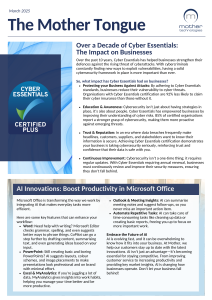In the ever-evolving technology world, it is better to prevent problems before they happen instead of fixing them afterwards. This shift represents a significant improvement in technology practices. Preventing issues in advance is now considered more effective than waiting to address them later. This transition is more than simply a change in approach, it is a shift in how businesses manage their IT infrastructure.
For years, the break-fix Approach was how many businesses dealt with IT support. Businesses would wait until something went wrong before contacting IT support to resolve the issue. This reactive strategy led to costly unplanned downtime and interrupted operations.
In addition, businesses struggled to estimate when problems would arise, resulting in unpredictable IT expenses and increasing stress for a business. In essence, the break-fix approach was a reactive band-aid solution to IT support—a short-term fix for a long-term problem.
The challenges of the break-fix approach led to a rise in managed IT services. Unlike break-fix, managed IT services provide proactive IT support and management. Nowadays, MSPs should keep a close eye on their clients’ IT systems to prevent issues and keep everything running smoothly.
In today’s fast-paced world, when technology is the backbone of businesses, implementing a proactive IT support strategy is not only important but also critical.
Continuous Monitoring: Constantly monitoring a business’s IT systems, networks, and infrastructure is the cornerstone of ensuring seamless IT operations. By keeping a watchful eye, potential issues can be identified and addressed early on. Doing so prevents them from escalating into disruptive incidents before impacting the entire business.
Maintenance: To keep your computers or systems operating smoothly and effectively, perform routine maintenance tasks like software updates, patch management, hardware inspections, and system optimisation rather than waiting for something to break.
Cybersecurity Measures: Comprehensive cybersecurity measures include a proactive approach that extends beyond mere reactive responses. By deploying a suite of robust security protocols, including advanced firewalls, cutting-edge Endpoint Detection and Response (EDR) systems, antivirus software, and access controls, organisations can strengthen their defences against potential cyber threats.
These precautions actively prevent sensitive information and important data from being accessed or used by cybercriminals. In an era when cyber threats grow and threats have never been higher, deploying such proactive security measures is not only a wise investment but also a necessary precaution for any company’s reputation.
The transition from break-fix to predictive maintenance offers several benefits for businesses:
Minimised Downtime: By addressing potential issues before they escalate, businesses can avoid costly downtime and maintain employee productivity.
Cost Savings: Proactive maintenance helps companies cut IT expenses by avoiding costly emergency repairs and optimising the use of resources.
Enhanced Security: Proactively identifying and troubleshooting security vulnerabilities helps businesses reduce the risk of cyberattacks and data breaches.
Improved Scalability: Predictive maintenance enables businesses to successfully scale their IT infrastructure, helping growth while maintaining reliability and efficiency.
In conclusion, the evolution from the reactive break-fix model to proactive IT support signifies a significant leap forward in how businesses manage their IT infrastructure. Businesses can minimise downtime, optimise resources, enhance security, and scale effectively in today’s digital world.

Read the newest edition of The Mother Tongue, packed with fresh tech insights and company updates.
